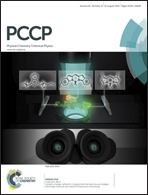Quantum chemical and matrix-IR characterization of CH3CN–BCl3: a complex with two distinct minima along the B–N bond potential†
Abstract
We have characterized the structural and energetic properties of CH3CN–BCl3via computations and matrix-IR spectroscopy. We find two equilibrium structures of the complex via computations. At the MP2/aug-cc-pVTZ level, the global minimum energy structure has a B–N distance of 1.601 Å, and a binding energy of 12.0 kcal mol−1. The secondary structure lies 7.1 kcal mol−1 higher in energy with a B–N distance of 2.687 Å and a binding energy of 4.9 kcal mol−1. Computational scans of the B–N potential curve using both DFT and post-HF methods indicate that a significant barrier exists between these structures, and that it lies 1 to 2 kcal mol−1 above the secondary minimum at a B–N distance of about 2.2 Å. We also observed several key, structurally-sensitive IR bands for six isotopic forms of the complex in neon matrices, including: the B–Cl asymmetric stretching band (νaBCl) at 792 cm−1 and the C–N stretching band (νCN) at 2380 cm−1 (for the primary isotopomer, CH3C14N–11BCl3). These frequencies are consistent with computational predictions for the minimum-energy form of the complex. Energy decomposition analyses were conducted for CH3CN–BCl3 and also two related complexes, CH3CN–BF3 and CH3CN–BH3. These provide insight into the trend in Lewis acidity of the BX3 acceptors toward nitriles. Furthermore, these analyses indicate that the barrier along the B–N potential of CH3CN–BCl3 results from Pauli repulsion between the π electrons on the nitrile moiety and the chlorine atoms in BCl3, which is significant at relatively long distances where attractive bonding interactions fail to overcome it.


 Please wait while we load your content...
Please wait while we load your content...